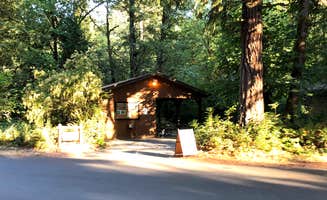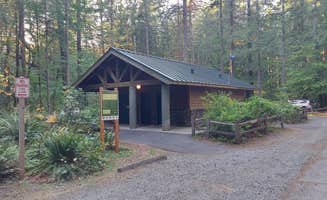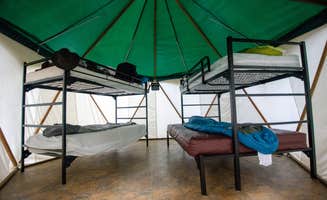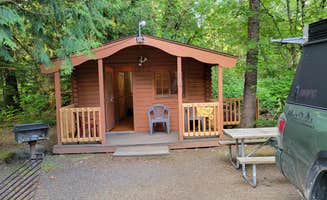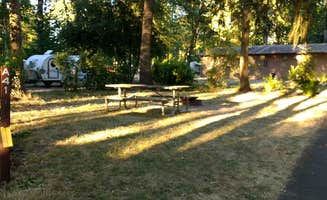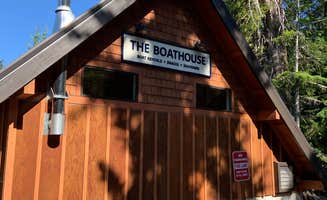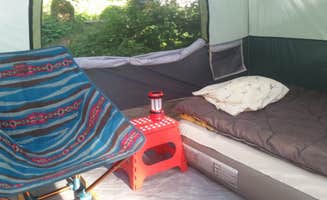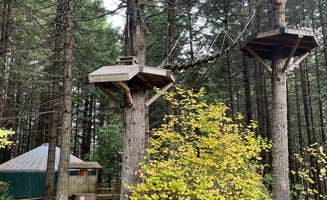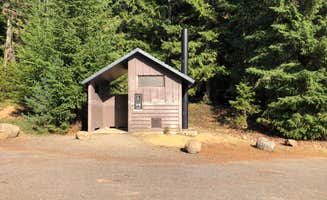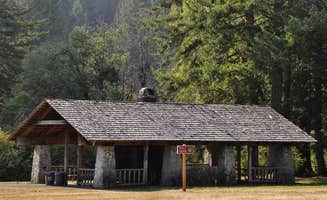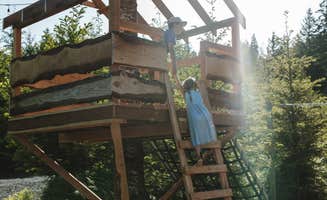The Clackamas River valley features diverse camping options within 30 miles of Eagle Creek, ranging from 200 to 1,200 feet elevation. Year-round precipitation keeps the forests lush, but summer temperatures often reach 85-90°F, creating ideal conditions for water activities. Glamping close to Eagle Creek, Oregon provides an alternative to traditional camping for those wanting easy access to nature without sacrificing comforts.
What to do
Hiking on diverse trails: The region offers trails for all skill levels at Milo McIver State Park, where visitors can explore multiple ecosystems. "There are private feeling hiking trails around the large park. The campground area is a standard State Park area, mostly private sites tucked into the trees," notes Nancy H. These trails connect to wider regional networks and wildlife viewing areas.
Fishing in stocked waters: The North Fork Reservoir at Promontory Park offers fishing opportunities with dedicated areas for young anglers. "There is easy water access with a pier for fishing. Within a mile up the road is a marina and boat ramp," explains Hahns R. Many campers report catching multiple fish during their stays, making this an excellent option for beginners.
Swimming in natural settings: Several campgrounds offer direct river or lake access where you can cool off in summer. "The lake is picturesque! The drive to it was amazing too with breathtaking views," shares Molly H. about Trillium Lake. Most swimming areas lack lifeguards, so personal flotation devices are recommended for children and inexperienced swimmers.
What campers like
Proximity to Portland: Many campgrounds in the Eagle Creek area serve as convenient escapes from urban life while remaining accessible. "Oxbow feels like it is in the middle of nowhere but it's easy to get to and practically within the city limits of Portland," states Stephanie Z. about Oxbow Regional Park. This allows for spontaneous weekend camping trips without extensive planning.
Private campsites: The region's campgrounds often feature well-separated sites with natural barriers. "The outer loop sites are quiet, spacious and wooded. They are also very close to a trailhead to nice hikes and the beach," explains Finn M. about Oxbow Regional Park. This natural spacing provides a sense of seclusion even on busy weekends.
Access to water recreation: Most popular campgrounds feature direct access to rivers or lakes for multiple activities. "Great access to the river to keep cool in summer. Nice sandy beaches. Park also has a lot of sheltered picnic areas and playground," notes Marcus K. Many sites allow for launching kayaks or paddleboards directly from camp, eliminating the need to transport equipment.
What you should know
Reservation requirements: Most glamping sites near Eagle Creek require advance booking, especially during summer. At Mt Hood Village Resort, "it's more of an RV campground. But, it does have several yurts, and a tent camping area," explains Alan N. Sites with premium amenities typically fill 3-6 months in advance during peak season.
Seasonal considerations: Facilities at many campgrounds operate on limited schedules outside summer months. "The stocked kid's pond doesn't have much fish throughout the summer because they can't survive the heat BUT, this information isn't on their website," Jill T. explains about Promontory Park. Weather conditions may affect both amenities and access roads.
Variable connectivity: Cell service ranges from non-existent to spotty throughout the region. "Barely got 1 bar of 4g at the welcome center. There's a guest wifi in the parking lot there too but it's 2 miles further to the camp ground and texts hardly go through," reports Zach S. about Oxbow Regional Park. Plan accordingly if you need to stay connected during your stay.
Tips for camping with families
Child-friendly activities: Many campgrounds offer structured programs specifically for younger visitors. "Great place for a family. We were in our van so had one of the RV sites with electricity, not one of the canvas tents with platforms," shares Sarah S. about Roamer Sites. "Campers can use the gym and trampoline that's available for the kids staying at the youth camp."
Safety considerations: Rivers and lakes present natural hazards requiring parental supervision. "There is a play area for the kiddos along with walking paths along the water," Tyson C. notes about Roamer Sites. Facilities often include marked swimming areas, but most lack lifeguards and have variable water conditions.
Accessibility challenges: Terrain varies significantly between sites, affecting mobility for strollers and young children. "The park has a little everything. GREAT biking trails that are kid friendly. There lots of historical sites around the campground to enjoy as well," explains Scott W. about Champoeg State Park. Paths between facilities may involve hills or unimproved surfaces.
Tips from RVers
Site selection strategy: RVers recommend researching specific site dimensions before booking. "Easy to access, even for larger rigs. We stayed in 39 foot 5th wheel. Plenty of pull thru spots, full hookups, regularly spaced bathroom/showers," advises Steve R. about Mt Hood Village Resort. Corner sites typically offer more privacy and space for outdoor setup.
Hookup limitations: Electric and water connections vary widely between campgrounds. "The full hook up sites are in old growth timber giving each site a feeling is seclusion. The lodge, pool, hot tub and saunas are in good condition," notes Jack B. Even sites with full hookups may have limitations on amperage or water pressure.
Access road challenges: Some campgrounds have steep entry roads or tight turns that challenge larger rigs. "I have a 36' RV and had a little trouble getting my RV into my reserved site, but there are others that have easier access for large rigs," reports Hahns R. about Promontory Park. Research specific route limitations before selecting glamping accommodations near Eagle Creek.


